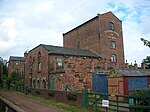Hewell Grange is a former country house in Tardebigge, Worcestershire, England. "One of the most important late 19th century country houses in England", the mansion was built between 1884 and 1891 by George Frederick Bodley and Thomas Garner for Robert Windsor-Clive, later first Earl of Plymouth. Constructed in the Jacobethan style, it was "perhaps the last Victorian prodigy house". After the Second World War, the third earl sold the Hewell estate to the Crown and it was redeveloped as a prison. The mansion was used to house young offenders, and later low-risk prisoners, while adult prisons were built in the grounds. The site was subsequently consolidated as HM Prison Hewell. In 2019, the Ministry of Justice announced the closure of the Category D open prison housed in Hewell Grange, after a highly critical report by Her Majesty's Inspectorate of Prisons.
The Windsor-Clive family descended from Walter FitzOther, Constable of Windsor Castle during the reign of William the Conqueror. They came to Tardebigge in the 16th century and over the next two centuries expanded their land holdings in Worcestershire, Shropshire and South Wales. The development of the South Wales Coalfield in the 18th and 19th centuries saw their wealth greatly increase, as the coal was transported worldwide from their ports at Barry and Penarth. At his coming of age in 1878 Robert Windsor-Clive inherited some 30,500 acres and an income from ground rents and port royalties which allowed him to undertake the building of Hewell Grange at a time when many landed aristocrats were facing retrenchment due to the Agricultural Depression. The Windsor-Clives lived in their new home for less than 50 years before consolidating their estates in Shropshire in the mid-20th century.
Hewell Grange is a Grade I listed building, its structure, interiors and setting having survived remarkably well despite over 70 years of institutional use. The park surrounding the house was landscaped by both Capability Brown and Humphry Repton and is graded II* on the National Register of Historic Parks and Gardens. The lake is a Site of Special Scientific Interest (SSSI). The ruins of an earlier hall stand near to the lake.









